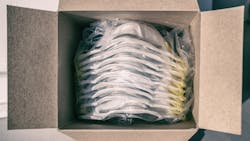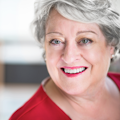Learning to adapt to pandemic challenges from each other
There is simply something magical about spending time with colleagues. We like learning from others who are facing the same challenges that we do every day. The last seven months have created an increased sense of isolation for many. Our dental hygiene Facebook groups are inundated with conversations every day. Hygienists are desperate to learn what is working for others. Staying connected has become more important than ever.
Conversations frequently deal with the sheer heat and physical discomfort that comes from wearing layer upon layer of PPE during the entire clinical day. This last summer I conducted a huge study that put a spotlight on how new PPE requirements are affecting clinicians both physically and emotionally.
Over the past few months, RDH eVillage has published a series of articles that describe some of the research findings and discuss strategies to reduce the impact of working in an overheated situation. I will provide those links at the end of the article.
The importance of connecting live
In September, RDH magazine hosted a live roundtable to discuss these matters. As moderator, I invited two clinical dental hygienists to share their experiences about coping in today’s clinical world. Coincidently, my two panelists both live and practice in the greater Seattle area. While they know each other personally, their life situations and backgrounds could not be more different, but they share a common passion for dental hygiene and a strong conviction to serve people.
Paige has been in clinical practice for over four decades, and recently joined an established practice where she treats patients four days a week. Her treatment room is in a multistory 1980’s building built like a green house, complete with a large interior atrium and lots of glass windows. Paige’s treatment room is in the corner of the building and has direct exposure to midday and late afternoon sun.
Danielle only received her dental hygiene license a few years ago, and recently transitioned back into the temping world. As a hygienist du jour, there is no way to know in advance what her day will be like. While temping opportunities are plentiful in the Seattle area right now, everything else varies from one day to the next.
Research results
Here is a sneak peek into the round table conversation that night.
As the moderator, the discussion started with the current statistics about the effects of PPE on health care workers. The study design collected information about 65 different physical and emotional data points. Out of 4,581 survey participants, 3,595 were dental hygienists.
Paige opened with the dehydration and overheating statistics. This abbreviated list indicates clinicians are overheated and dealing with hydration issues.
- dehydration – 65%
- headaches – 59%
- exhaustion – 56%
- dry mouth – 54%
- profuse sweating – 4%
- mouth breathing – 40%
- dizziness/lightheaded – 36%
Danielle covered the respiratory PPE information, usage patterns, breathing impacts, and how often clinicians removed their PPE devices during the day.
- respirator mask + surgical mask + shield – 60%
- surgical mask + shield – 30%
- only take PPE off at lunch - 63%
- never take off PPE during entire workday – 7%
- hard time breathing – all of the time – 43%
- occasional breathing problems – 44%
The final statistic: 71% of all respondents reported an increase in overall physical and emotional symptoms since COVID-19 protocols were instituted.
Having a conversation with the team
Paige is a data gatherer. Within days of returning, she figured out her treatment room was a proverbial hotbox. Rather than come across as a whiner, Paige purchased a digital thermometer and started keeping track of the room temperature. The morning was not bad, but that changed by midday. Her personal trigger was 74.5 degrees. Armed with real data, Paige presented the information to the doctor and team members.
This action triggered an investigation into the air-conditioning capacity in her room. The inspection revealed the room was at the physical end of the airflow pathway. Due to the age of the building, any improvement would require a major equipment overhaul.
Once it became clear that reworking the room AC and ventilation was not a viable option, Paige started sending messages to team members. Her messages were short, to the point, and full of humor, such as “I’m starting to glow back here.” This signaled the team to make a thermostat adjustment. The patient check-in and screening protocol were revamped. Rather than racing down multiple flights of stairs, patients now come to the atrium landing for their temperature checks. Danielle’s observations also initiated a conversation about the scheduling sufficient turnaround time between patients.
Hydration strategies
Danielle’s hydration and nutrition requirements are very specific. Eighteen months ago, she underwent bariatric surgery. Danielle needs to adhere to a very specific schedule. Never one to shy away from a subject, Danielle makes sure all employers know regular and adequate hydration is critical to her continued health. Because she initiates the conversation, there has never been an issue.
Paige’s office created a designated hydration station. There is a shelf in the hallway with each team member’s personal drinking utensil, so it is easy to take a quick hydration break. Paige and her coworkers are focused on trying to drink as much liquid as possible during the day. Interestingly the shelf was populated with all types of beverages from plain water, to energy drinks, to drinks marketed to boost hydration.
An unexpected opportunity
Both Paige and Danielle understand the health effects that crop up when the oral cavity stays dry for a long period of time. About six weeks before the roundtable discussion, both received a bottle of Cavity pHighter Test Strips. This new test strip records both salivary pH and buffering in less than a minute. Paige started testing her own saliva and discovered that she now has dry mouth issues. She also tested her husband’s saliva. His results indicated low salivary pH and buffering levels. The findings did not surprise Paige. Her husband’s favorite nonalcoholic beverage was a huge culprit. Now there was independent data to support her concerns.
Paige then tested coworkers and patients. The results were startling to most. One doctor was really proud of his healthy pH level, but dismayed to learn that he has a poor buffering capacity, a situation that substantially increases his decay risk, especially when his mouth is dry. Paige also took the time to include the test strips in patient assessments.
Danielle and I are what you might call chatty. We love verbal interactions with people and the pandemic made it really hard for Danielle to talk. The challenge of breathing with all of the PPE made Danielle feel cut off from meaningful patient interaction, and her focus shifted to how hot and uncomfortable she felt. While she knew that this was not right, she felt trapped in her own discomfort. Her mind kept focusing on how hot she was.
The current COVID-19 crisis was affecting people in so many different ways. Danielle realized she was seeing more patients with new decay, and she was treating more were experiencing dry mouth issues. When Danielle incorporated the Cavity pHighter Test Strips into her appointments, her frame of mind began to change. She had a new tool to help patients understand why their disease risk was higher. This simple test allowed Danielle to reengage with patients in a meaningful way. Testing salivary pH and buffering was just the distraction she needed to refocus and reset her mind to what she does best—providing optimal patient care.
The final strategy
Both Paige and Danielle needed a buffer between their clinical job responsibilities and their home lives. Their emotional and physical reset strategies were different. Danielle is a single mom with an 10-year-old son. Danielle sits in her car for 10 to 15 minutes when she arrives home, listening to music or just absorbing some quiet time. When she emerges, she is refreshed and ready to spend quality time with her active son.
Paige and her husband have been married for years and are now empty nesters. Swimming is Paige’s personal “me time” and a welcome source of exercise. On the way home she stops and swims laps at a local pool to keep her upper body musculature healthy while creating a personal reset.
A round of applause, please
Events like this simply do not happen in a vacuum. They take careful planning and financial support. Paige, Danielle, and I want to say thank you to RDH magazine for embracing our vision and to the CAO Group for providing the necessary funding!
Special thanks go to Denson Cao, PhD. When I first met Dr. Cao, I knew I was having a conversation with a visionary who simply wants to help us do things better. He and his team at the are true dental hygiene allies who support the value of open dialogues. I encourage all of you to become familiar with the Utah-based CAO Group and learn more about their product suite that includes diode lasers, PPE, aerosol vacuum stations, whitening, and preventive products and to incorporate innovative testing products like Cavity pHighter strips and mints into your clinical practices.
Related articles by Anne Guignon
- Headaches, exhaustion, anxiety: The physical and emotional challenges of returning to work during the pandemic
- Hot under the collar: Practical strategies for PPE-related overheating
- Respiratory PPE, dry mouth, and COVID-19: Why you need to know your own CAMBRA score
- Are you more than just thirsty? The dangerous impacts of dehydration
Meet the panelists!
Paige Cowan Seaborg, BS, RDH
Paige always wants to understand the “why” behind the treatment protocol or product recommendations. Paige’s scientific curiosity has played a key role in how she has provided clinical care for more than four decades. Page is a voracious consumer of scientific information and is a master at translating the science into a clinically applicable plan that she uses on a daily basis. Paige has an uncanny ability to always see the world from another perspective, a skill she honed as she and her husband raised two daughters, one biological and the other internationally adopted. Her frequent contributions on numerous social media platforms bring a sense of wisdom and calm to complex discussions.
Danielle Mora, BAS, RDH
Danielle came to the dental hygiene profession with an unusual background. Prior to dental hygiene, she was a tour boat captain where she learned to navigate complicated situations while keeping everyone calm. Today she uses these skills clinically and in in helping her ten-year-old son stay focused and feeling safe today’s complicated world. As a young clinician, Danielle, has a keen understanding that school simply taught the basics, and that her growth as a clinician and world citizen is her responsibility. She can see the big health-care picture and is simply not afraid to test out a sea full of new ideas. Danielle’s next plan is to get a graduate degree in public health.
ANNE NUGENT GUIGNON, MPH, RDH, CSP, has received numerous accolades over four decades for mentoring, research, and guiding her profession. As an international speaker and prolific author, Guignon focuses is on the oral microbiome, erosion, hypersensitivity, salivary dysfunction, ergonomics, and employee law issues. She may be contacted at [email protected].
About the Author
Anne Nugent Guignon, MPH, RDH, CSP
ANNE NUGENT GUIGNON, MPH, RDH, CSP, has received numerous accolades over four decades for mentoring, research, and guiding her profession. As an international speaker and prolific author, Guignon focuses is on the oral microbiome, erosion, hypersensitivity, salivary dysfunction, ergonomics, and employee law issues. She may be contacted at [email protected].

